|
FAQs about Zoanthid
Identification
3
Related Articles: Zoanthids, Sea Mat: An
Ocean Of Color For The Aquarium by Blane Perun,
Related FAQs: Zoanthid ID
1, Zoanthid ID 2, Zoanthid ID 4, Zoanthid
ID 5, & Zoanthids, Zoanthids 2, Zoanthids 3, Zoanthid Behavior, Zoanthid Compatibility, Zoanthid Selection, Zoanthid System, Zoanthid Lighting, Zoanthid Feeding, Zoanthid Health, Zoanthid Reproduction,
|
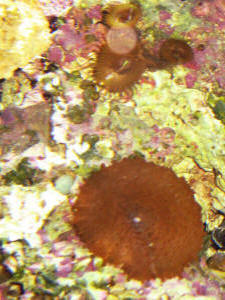
|
|
Zoanthid or pest anemone? 12/14/08 I
just want to thank you all for your priceless service. I have
enjoyed your site for years. I just sent an incomplete email a
moment ago, my apologies. I forgot to mention that I browsed all
of your Zoanthid ID pages, and all 20-something of your anemone
pages, and didn't see anything quite like these. <I
see> I have attached a pic of some supposed Zoanthids that I
was given by a local shop. They also look a lot like some pest
anemones I have seen. They had come loose from a frag and covered
the shop's frag tank wall. I scraped off a dozen or so and
superglued them to the rock in the pic. <Okay> They spread
on a translucent white base a lot like some clove polyps do--- on
runners that form a tangled mat. <Ahh! A good clue> They
are about 1/2" diameter and the tentacles are only a single
row around the disc. Would you say they are an anemone or a
Zoanthid type? <The latter> I have never seen a pest
anemone spread on runners before, but that isn't saying much
coming from me. Oh, and they are being kept in a 10 gallon Nano
with a bull shark. <Heeee! With the emphasis on bull!> Do
you think the bull shark would host a Condylactis anemone? Or
should I try one of those pretty pink sebae anemones? ;) <I
think we might start a Bob and Matt comedy routine!> Thanks!!!
Matt <Do take a read here: www.wetwebmedia.com/zoanthid.htm re
the table detailing the differences twixt Zoanthids and
Actinarians... and here: http://wetwebmedia.com/anemoniafaqs.htm
for some pix of Anemonia... are similar, but note the
"number, arrangement of tentacles"... and the mat
appearance you mention. Oh, and the usual cautionary remarks re
Zoanthid keeping, handling... and watch out for bites from the
Carcharhinus leucas... Bob Fenner>
|
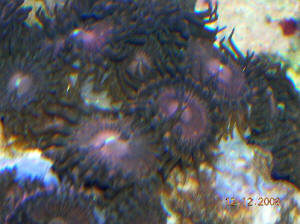 |
Zoanthus vs. Palythoa vs. Protopalythoa: Palytoxin
07/07/08 Hi WWM crew, <Hello Brian! Sorry about the slow
response, I was asleep at the wheel...> I'm writing you about
Palytoxin because I so far cannot find concrete answers about it
anywhere and I have children and pets around my tanks. <Yes...many
stories, few facts available to the hobbyist> This is my first
letter to you all after many readings (including reading many of your
letters on Zoanthidea and Palytoxin). I have a few quick questions and
I would appreciate any citations to additional resources you can give,
the more scientific the better. I'm trying to get hold of the Book
of Coral Propagation by Anthony and Corals and Coral Reefs by Eric
Borneman since I hear they have good info on Palytoxin but no luck so
far (they're expensive!). <Calfo gives some anecdotal info that
is helpful- cautionary - to the hobbyist. If you're interested in
scientific texts on Palytoxins you might try a local library or
(preferably) a college library where you can gain access to scholarly
journals. Perhaps a search of scholar.google.com or JSTOR would be
fruitful in this area.> (1) How can you tell the difference between
a Zoanthus, a Palythoa, and a Protopalythoa species of Zoanthidea? I
would like to concretely identify what is in my tank and learn how to
ID future specimens. <As I understand it, this largely relates to
the common foot. As hobbyists Zoanthus are the smaller, more colorful
polyps sharing a foot; Parazoanthus being larger, more distinctly
carnivorous, and still sharing a common foot, and the
Palythoa/Protopalythoa being colonies of unconnected large polyps>
(2) Do all Zoanthidea species have Palytoxin in them? I know that even
within Palythoa, not all specimens have Palytoxin in them, but I'm
wondering here whether all 3 species have Palytoxin or if, for example,
Zoanthus are safe and do not have it. <All of these families may/do
produce Palytoxin and other organic poisons> (3) If not all
Zoanthidea have Palytoxin, which ones do not have it? <Can't be
told based on appearance, unfortunately. We must suspect all...for
safety reasons> (4) Where is the Palytoxin actually "kept"
in the Zoanthidea? Is it ever released other than when the specimen is
damaged or cut? How is it released (I've read about it squirting
out of Zoanthus but never seen anything on how they actually release
it)? <It is held in the fluid of the mesophyl, exuded in mucous, as
an allelopathic compound.> (5) Is Palytoxin also harmful to other
things in the tank (e.g. other corals, fish, inverts, macroalgae,
etc.)? <Anything with nervous tissue, motor function> (6) I have
two Zoanthidea in my tank now that I was told, when buying them, were
Zoanthus. I knew nothing about Palytoxins so didn't ask any
questions beyond that identification. They have spread off the original
frag/rock/disc they came on and some of the polyps are bridging the gap
between the frag disc and the live rock. If it turns out these are a
species that sometimes contains Palytoxin I'll probably not keep
them, the risk seems not worth it despite their beauty. How should I go
about removing them from the tank to minimize the risk of Palytoxin
exposure? <The only way to eliminate exposure would be to take the
polyps and the rocks they are on, bag them in garbage sacks, and
dispose of them.> I've taken up a lot of your time already, so
I'll stop here. Thank you again for your answers. <Unless these
creatures are handled, Palytoxin poisoning is unlikely. If you are
concerned about colony size or a child reaching a hand in the tank,
removing these is probably prudent. DO take care in handling them
(gloves, goggles, etc.) especially if they have been severed or
crushed.> Sincerely, Brian
<Benjamin>
|
ID help, please 2/5/08 Hey Crew, <Andy>
Presently curing a batch of live rock pending setting up my tank
in March, and came across these on a small piece of rubble; not a
great picture, I know, but any thoughts you might have are much
appreciated. I¹ve searched all of the sponge and
anemone ID pages, and I¹m not having any luck. I
don¹t THINK they¹re Aiptasia, but
I¹m a relatively new to the hobby haven¹t
seen all of the variants of that pest. What do you think, friend
or foe? Thanks, Andy <The larger batch of stalked polyps at
top? Please see here: http://wetwebmedia.com/zoidfaq2.htm and the
linked files above. Bob Fenner>
Re: ID help, please 2/5/08 Thanks, Bob.
Yeah, they do resemble the Palythoa, with one row of 6-8
tentacles. I thought I read that the Zoas are toxic, <Are, to
many organisms... including humans> but my hermit crab seemed
to enjoy them as a snack... twice. Looks like they're easy to
care for, as well. I'll keep looking to see if I can classify
them more accurately. Thanks! <A closer-up pic please.
BobF>
|
|
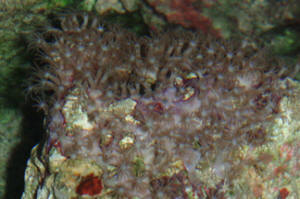
Re: ID help, please 2/5/08 Bob
(or crew), <Andy> Here¹s a little better
picture, not much, but such are the limitations of my little
digital camera. This is certainly a truer color. A friend
suggested these might be Green Star Polyps. <Does appear
to be a Clavulariid> Thanks again,
<BobF> |
|
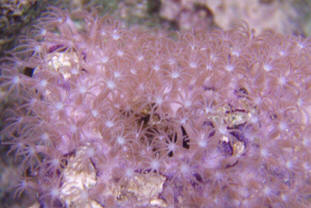
|
|
|
Corals ~ A Dummies Guide? Slug/Nudi ID, Tube
Polyp ID -12/26/2007 Good morning and Merry Christmas All,
So, I've finally gotten into some soft corals (tube polyps
and polyps) and I believe I may have a stony coral of some sort
that may not be doing so well (came in on some liverock).
I'll emphasize that I LOVE your website and you may be
familiar with my name from previous emails over the years...
however, I was curious as to whether you could recommend a book
for hobbyists just getting started with corals. I find your site
is likely better for people who know what they have and know what
they're talking about when it comes to corals. Is there a
good book you could recommend? <If you're looking for a
very simple guide, you can try this:
http://www.asira.org/caresheets As for books on captive coral
care, "Aquarium Corals" by Eric Borneman is one.
There's also, "The Super Simple Guide to Corals" by
James Fatherree you might like.> Thus far, it seems like the
fish stores I go to recommend soft corals for a beginner coral
hobbyist as they are easier to care for. I'd like to find a
resource that can guide me to repairing/nurturing the stony
corals that came in on the liverock and so as I can feel
comfortable in being responsible in buying stony corals down the
road and be able to care for them. <Hmm... it will be more
difficult to care for dying corals than for healthy ones. Why not
try starting out with healthy, cultured frags first?> Of note,
the stony corals have been around since about July. One little
colony seems to be dying (turning brownish) because it is shaded
within the tank. <Corals often change color to adapt to
different lighting conditions. Such a change, alone, is not a
sign that the coral is dying, or even unhealthy. Now, if it
bleaches out, then you have a problem and need to move the coral
and feed it generously until it gains its color back.> The
other 3 little colonies seem to be ok but they certainly
aren't growing fast and are too small for me to identify
them... but from the pictures on your site, they look like
stonies. Anyhow, a book/resource recommendation would be
grateful! <See above.> Merry Christmas and a Happy New
Year! <...and to you too :)> P.S. I mentioned to Bob that
I'd eventually get a picture of that little slug/Nudibranch
that was crawling in amongst my tube polyps the other day... it
is attached. It's about an inch long. Do you have a specific
ID on those tube polyps... other than me calling them...
'tube polyps'?? <Sorry I can't even begin to ID
the slug/Nudibranch for you from that picture (not focused
enough). The "tube polyps" you have are not a stony
coral (nor do they have calcified tubes). They are Zoanthids,
colonial anemones/corals. Please see here:
http://www.wetwebmedia.com/zoanthid.htm Best, Sara M.>
Re: Corals ~ A Dummies Guide? Slug/Nudi ID, Tube
Polyp ID... further on Zoanthid ID -12/27/07
Clarification... yes, I know the soft coral pic I provided was a
Zoanthid, was wondering what kind if it's possible to id. Ya,
the pic is pretty fuzzy of the Nudi/slug... can't get any
closer to focus properly... Oh well, it won't do any harm in
the tank I have it in now. <Unfortunately, I can't
properly/scientifically ID it (I doubt anyone could from a
photo). However, Zoa-loving hobbyists have given a lot of these
Zoanthids common names based on well described/photographed color
patterns which are surprisingly specific. Though I don't
think any of this assigning of common names has anything to do
with species ID, it's still fun. Thus, you might likely find
a common name for your Zoanthids here: http://www.zoaid.com/>
Thanks for the resource info!
<De nada,
Sara M.>
|
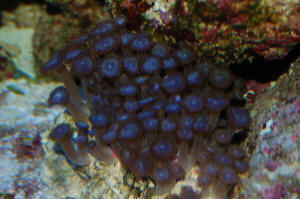 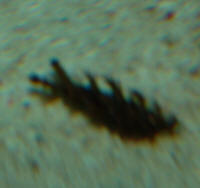 |
Zoanthid and Palythoa... Differences -11/27/2007
Hello Bob and WWM Crew!! <Hi Jerry, Mich here> I will make this
short and sweet. I have been studying on your site non-stop since I was
first broad sided by this obsession!! <Glad you found us!> My
animals love you, my bank account hates you!! You know how many changes
I have had to make from listening to the LFS in the beginning?!!
Anyways.. <Heehee! Live and learn my friend.> When I first
started a year ago, I was really into Zoanthids and I bought many of
them or so I thought and was told. After reading all the warnings about
the toxicity of the Palythoa colonies (even how they were first used
for poison on spears!!), I figured I would start to weed out the less
dynamic colonies. <Well both Palythoas and Zoanthids can be quite
toxic, and I would recommend using gloves to handle either, but they
can be safely kept in an aquarium. But really, if you enjoy the
Palythoa there is no reason to remove it from your system. > But for
the life of me how do you tell the difference? When I read about them,
they were described as the larger of the two. Well I have several
different colonies at different stages of growth, so there is my
confusion. At first I thought they were the ones with the longer
skirts, but after looking at pictures, I don't think that is even
it!! Help!! <Generally Palythoa are generally bigger and uglier than
Zoanthids. Some images of Palythoa here:
http://www.scientificcoral.com/images/2SoftCorals/SoftCorals1/B-132PalythoaMixed200.jpg
http://www.melevsreef.com/pics/0704/palythoa.jpg
http://home.nordnet.fr/~edhont/images/Aquario/Palythoa+parazoanthus_Gracilis_jaune.jpg
Zoanthids are generally more colorful and often have contrasting skirts
and eyes. http://images.google.com/imgres?imgurl= http://www.strictlyfrags.com/images/blueredzoo.JPG&imgrefurl=
http://www.strictlyfrags.com/zoanthid_polyps.htm&h=428&w=640&sz=47&hl=en&start=7&um=
1&tbnid=r0YynnrFoAJGHM:&tbnh=92&tbnw=137&prev=/images%3Fq%3DZoanthids%26svnum
%3D10%26um%3D1%26hl%3Den%26safe%3Doff%26client%3Dsafari%26rls%3Den%26sa%3DG
> Also when you are buying frags, they are all very small, how do
you tell the difference then? <In my experience, most frags that are
offered or desired are Zoanthids. Palythoa are offered and some are
attractive, but many are just big and brown. A good source if you are
really into Zoanthids here: http://www.zoaid.com/index.php > I have
one last goal of finding an affordable Blue Zoanthid colony.. key word
affordable!! <Find you local reef club and go to a frag swap. This
is your best source of inexpensive small frags. I have seen blue
Zoanthids offered many times at local frag events.> I would like to
remove all the Palys, like I did my Leathers and Colts, so I can take
this to the next level. <Palythoa and Zoanthids are both part of the
family Zoanthidea, so unless you are doing a species tank it is
difficult to get two more closely related corals.> Anyways, this
will probably land on your wall of stupid questions. (come on I know
you have one!!) <Heehee! Who let you in the secret room?> But
man, If I stay up another night trying to compare pictures (back and
forth, back and forth). I'm just gonna jump in my tank and make
like a fish!! <Heehee! Sounds like you might be a flounder!>
Thanks <Welcome! Mich> Jerry
Re: Zoanthid and Palythoa... Differences
11/28/2007 Thanks so much Mich!! <You are very welcome
Jerry!> Your guys are the best!! <Thanks for your kind words.>
Well by your detailed response, it seems I only have one colony of
Palythoa!! <Alrightee!> The rest are Zoanthids!! You made my
day.. <I'm very glad!> Have an awesome rest of the week
<Thank you Jerry, I wish you the same.> and thanks for your quick
response.. <Welcome! Mich> Jerry
|
Star Coral ID? Zoanthid? Hello again. You guys are SO
helpful...I can't stay away. <Me neither!> I researched
this all over your site, but I can't seem to find an answer.
I really need to know if I have pompom hydroids or this beautiful
sulfur yellow star coral. They both resemble each other enough to
worry and I can't tell from your images...so maybe you could
tell me? <Yes> At
http://www.wetwebmedia.com/alcyoniidsii.htm it shows some little
yellow star/sulfur corals. I believe I have that in my aquarium.
Another aquarist threw it out while cleaning his tank, and told
me he'd give me a puff of it, so I've incorporated it
into the aquarium, however at
http://www.wetwebmedia.com/hydrozoanfaqs.htm it has something
that looks a bit like them also. I don't want to make a
mistake and get a coral that will sting me such as a fire coral,
and I believe it's saying that the hydrozoans do sting?
I'm not sure after reading that. <They do sting...
Hydropolyps... some folks, body areas (less callused) more/less
than others> My coral is attached, and I want to know what it
is so I can be sure before keeping it. It comes in a nice soft
mat and hasn't stung me or anything, and it's kind of
like a little carpet of beautiful yellowish flowers. <Mmm,
sounds more like a Zoanthid...> Now, remember, this was given
to me as one little carpet clump and because I just set up this
new tank, I put it in there, stuck between some rocks. I can take
it out just as well, but it's so pretty...is it truly that
dangerous if it's pompom? <Is not a Hydroid...> Here is
the image. Please let me know what it is. I am worried. I
don't want to ruin my beautiful aquarium with something that
can kill me potentially or injure me. Thanks so much, ahead of
time. Naynay <Like the Hawaiian goose phonetically? I would
not be concerned here... Please read here:
http://wetwebmedia.com/zoanthid.htm and the linked files above...
for background info.. Send along a more close-up, highly resolved
image if you'd like a better ID. Cheers, Bob Fenner>
Re: Zoanthid ID... 11/11/07 Hello
again! With all due respect, <What does this mean exactly
anywho?> I do realize that your crew knows so much more than I
do about aquariums, however these don't look anything like
Zoanthids. <... Please read through WWM re Cnidarian taxonomy,
ID...> They resemble both pictures in the links I sent in the
first time. Can you go check them out in comparison to the image
I attached? Here is another image to help. I just want to be 100%
sure. Thanks! :) Here is the image. <This is the same dismal
low res. pic... PLEASE, something better resolved... macro,
close-up... Perhaps a few books, some hours in a library... Bob
Fenner>
|
|
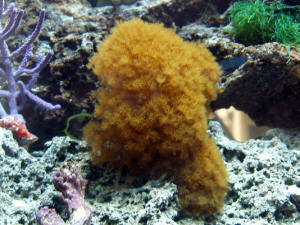
|
Button Polyps? 10/27/07 Hi there and thanks
in advance for your assistance. Could you please confirm that these
are some sort of button polyps and not a pest similar to Aiptasia?
<The photos are really small, but they look like button polyps
to me.> If so then are they safe from a peppermint shrimp
feeding frenzy? Much appreciated. <I've never heard of
peppermint shrimp being a threat to Zoanthids.> <Best,
Sara M.> |
|
 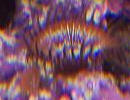 Zoanthids. RMF Zoanthids. RMF
|
Polyp identification 9/2/07 Ok,
question # 2 today. I just purchased some live rock and they have
these two items on them, one is what I believe to be button polyps
in the attached picture (the large ones on the right)
<"Button polyps" or Palythoa/Zoanthids, whatever you
want to call them. They're colonial cnidarians of the Order
Zoanthidea.> what I can't identify through searching the
FAQ's is the pink tipped green anemone looking things on the
right. <It seems that there are a lot of these types of little
anemones which come in as hitchhikers. I've seen them called
"majano" or "tulip" anemones. I don't know
much about their specific taxonomy or even if they're all the
same genus/species. Pretty much all I can tell you with any
certainty is that they're common and tend to be harmless. For
some people they become pests (by going forth to be fruitful and
multiple). However, generally it seems they are less often a
nuisance than are Aiptasia. Personally, I think they're cool
and I actually tried to get them to multiply in my tank without any
success. So, basically it's a gamble. They might become a
nuisance or they might not.> My question is what are these two
species, and what do I do to keep them, I.e.. feeding, lighting?
<You shouldn't have to feed them specifically. If you
generally feed the tank well, they should get what they need. Both
cnidarians like high light but can usually adapt to less light.>
Thanks Dan_
<De Sara M.> |
|
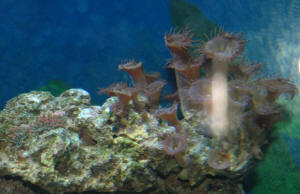 and bonus Anemonia majano at left! RMF. and bonus Anemonia majano at left! RMF.
|
Marine Betta not Feeding Picture... ID Palythoa
-- 08/26/07 Including the picture often helps. <Yep!> The
coral I am curious about is on the left. <Mmm, hope you mean
top.> I assumed for a long time that they were rock anemones but
now I actually have some glass anemones which look entirely
different. <The corals in your picture include a mushroom on the
bottom and on the top are Palythoa. More here: http://www.wetwebmedia.com/zoanthid.htm
Similar photos here: http://www.wetwebmedia.com/zoidfaq2.htm
> Thanks,
<Welcome!>
<Mich> |
|

|
|
|

